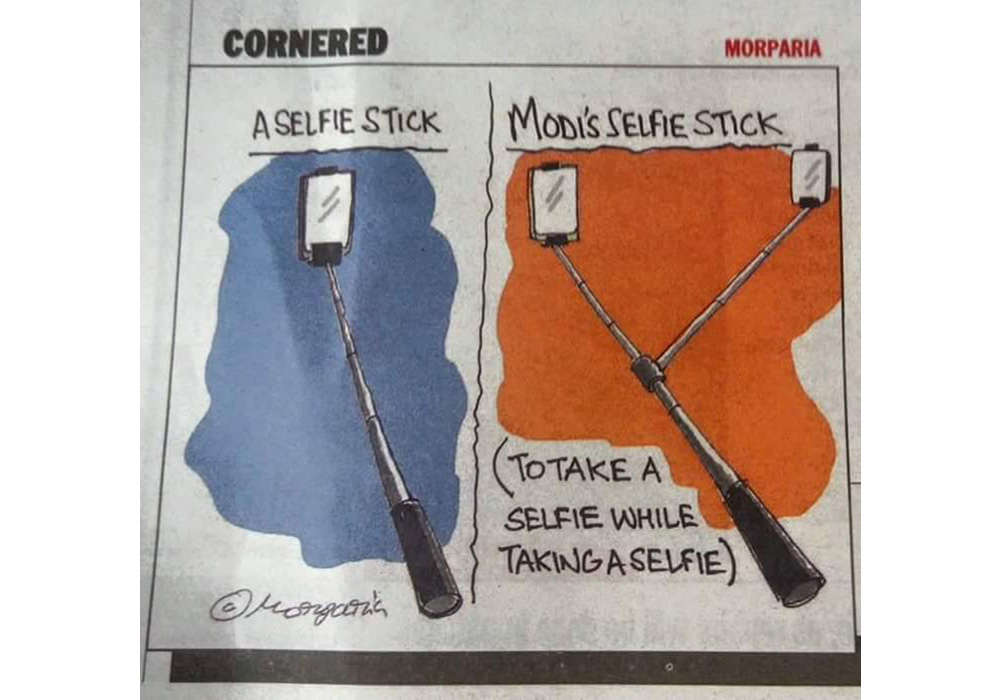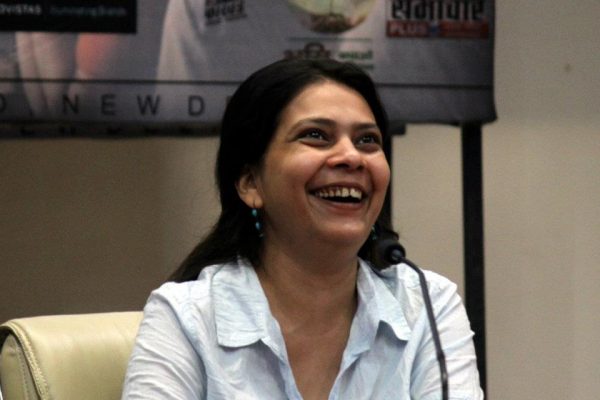What does that cellphone camera capture when you point it at yourself and pout? More importantly, what gets left out? Amit Sengupta explores the consequences of replacing cultural memory with the cold-blooded, cold-storaged memory of the archives.
“And when you gaze long into an abyss, the abyss also gazes into you.”
—Friedrich Nietzsche
“Every kind for itself and its own, for me mine male and female,
For me those that have been boys and that love women,
For me the man that is proud and feels how it stings to be slighted,
For me the sweet-heart and the old maid, for me mothers and the mothers of mothers,
For me lips that have smiled, eyes that have shed tears,
For me children and the begetters of children.”
—Walt Whitman, ‘Song of Myself’
In slow motion, the heat is aggressive. It is not alien. It enters the soul and stays. You just can’t click it as a backdrop for the nth million selfie. If you gaze at the heat, it also gazes back into you. It moves like an inevitable flashback on the snake-filled SUV street of the aggressive, alienated capital metropolis, like a sunflower moulted into an elongated installation of black tar, celebrating the scorching, sweaty sunlight sans sensuality or humidity. It moves inside the large dilated eyelids and light eyes of summer in the slow camouflaged dictatorship of a democracy without remorse or repentance. Bare-bodied, emaciated men carry the burden of their daily wages inside the dark of their eyes. Little children burnt by the sun at the crossroads, barefoot, selling roses, staring through plastic windows of plastic faces inside swanky cars. Female construction workers and primitive food-gatherers of globalised affluent societies, cooking food on the evening pavement, the blue tarpaulin which is their home fluttering with the ‘escape velocity’ of the traffic. Gunshots inside a restaurant, the murder as a dinner and drinks spectacle, as the lines merge between this and that criminal. Little girls raped and bludgeoned and left on the railway tracks. Violence stalks, like familiarities, rituals and clichés.
The good days are never coming; they will never come. They are all the manufactured consent of the dream merchants of ad agencies. Farmers hang themselves, untouched by the glorious promises of the power establishment. The barbarism of our civilisation is so predictable and the predicated mindlessness of it so terribly banal that no selfie can dare capture it. In this celebration of narcissism, only pouted lips are glorified, ephemeralised and fossilised the moment it is immortalised, dumped into the garbage can of cellphone history, forever lost into the new quagmire of the breathless, relentless, self-gloating, “Oh! I am so much in love with myself” narcissist.
The good days are never coming; they will never come. They are all the manufactured consent of the dream merchants of ad agencies.
Despite the action replay of mushy, often sexist, life-is-good ads for mobiles and automobiles, there is not a moment of redemption in these Sensex condemnations of neoliberal times. Time flies with the insatiable curse of backward capitalism’s vicious trance and gigantic economic and social disparities, travelling like poison through primetime shouting matches into the banal and fraudulent statistics of 26 May 2015, the first absolute-majority anniversary of neo-fascism, with the Selfie as Statecraft. And look at the upwardly mobile classes and NRIs rocking with the rock star, cell phones forever clicking that forever moment of megalomania! What a great leap of imagination! Even Hobbes and Machiavelli would be amused.
At least you can pretend to believe in democracy even if you are basically a neo-fascist, dreaming of the vimanas of the ancient times and how Ganesha, who once drank millions of tonnes of milk in this starkly malnourished country, fixed his elephant trunk with plastic surgery. So how did the terracotta figurines fix their solid, unbreakable bodies into centuries of stoic silence? How did their gaze become a mask, and their mask became a gaze? And, besides, how come they never chose to wear fancy sunglasses inside a darkened museum?
Sometimes, this Dear Leader gazes at the CCTV near a commemorative flower-laden ‘memorial’ in a foreign land as if the dead are also watching. Is the CCTV watching it all live, or can it look beyond, into the primordial inevitability of death? Can the dead take their selfies? Indeed, are we at all interested in the dead? Do we, the superpower that we have become in just about one year (born ashamed as we were in the past), love our memories, cherish them, respect them, hold them inside our eyes and our hearts, in the palm of our hands, like dew drops?
Are the dead ashamed of being Indians?
Come and see the blood on the streets, wrote Pablo Neruda. Come and see the blood on the streets. Come…and see…the blood on the streets. Can a selfie capture the street in slow motion?
The dead at Kargil, the dead in Dantewada and Abhujmaad, the dead in Kalinganagar and Hashimpura, the dead in Vidarbha and Telengana, across the heart-rending rural landscape of village India, their selfies not even a damned silent painting, like Munch’s Scream? Can a selfie capture a scream?
What about those Indian citizens, young women, little children, elderly men, who were gang raped and butchered and thrown live into street fires in cold blood in state-sponsored public spectacles in Delhi 1984, Hashimpura 1987, Bombay 1992-93, Gujarat 2002—were they all ashamed of being Indians? Would they have clicked a selfie with all our great patriotic helmsmen of the justice system and all the masks of the Dear Leader if they were alive? Would they have put on fancy dark shades inside a museum manufactured in their memory, perhaps with terracotta figures with stoic faces? Would we click them, immortalise them, fossilise them, as they watch their own memories float back from the past and enter the glorious selfdom of the kingdom of ‘acche din’, manufactured by ad gurus, personified and promised by the Dear Leader himself?
Come and see the blood on the streets, wrote Pablo Neruda. Come and see the blood on the streets. Come…and see…the blood on the streets. Can a selfie capture the street in slow motion?
Do we retain the memory of our fragmented, scattered, ravaged geography, our degraded forests and pristine rivers turned into dirty gutters and sewage drains of our civilisational genius, the unbearable lightness of forgetting, the indignity of slavery, the landscape of massacres and genocides, the mass hanging of revolutionaries in 1857 and after—on trees, lampposts, pillars, their dark “native” bodies blown apart tied on canons—the hanging of freedom fighters and the dark holes of kala pani prisons, the poetry written with idealism and fire and dreams, the beginning of history which would never anticipate the end? Has memory been archived inside the latest gadget of yet another touchscreen smartphone—text, silences, sepia-toned images, hand-painted pictures, box camera stills, sundry sketches, etched screenshots, still, unmoving cinematic moments, dying drawings, love letters flying on the wings of desire in eclectic trembling hands, touch, lips, skin, smell, cotton shirts, the faded flowers and leaves and petals inside the books when romance and radicalism made a symphony and a synthesis?
I touch you, and you ripple like a river, wrote Pablo Neruda. There are loves and loves and the possibilities of love; there is memory and memory and the possibilities of memories; touch and touch, and the infinite, ephemeral possibilities of touch; there is fun and there are joys and there are seasons in the sun, and drunken frolics on rocks and behind bushes, and furtive looks and furtive groping, and the liberation of youth and the sacred spaces of sharing; the mind soaring in confusion and delight, the song floating, the journeys of sudden friendships like eternal flames, the flames dying before they are lit; the books unread, the pages unchecked, the Facebook posts and pics falling off the map into n eternal twilight zones of renewal and elimination; the leaves falling like seasons and the seasons becoming time-future and time-past, never to return; the glasses tinkling, the intoxication still inkling; the classroom corridors silent and empty.
There are clicks and clicks and the cold-blooded, cold-storaged possibilities of the memory of archives. Are they all enclosed in the quick, fleeting, unthinking, unwavering, relentless, repetitive, run-of-the-mill, artless, tactless, loveless, joyless, pouted lips of the damned cellphone?
Life is elsewhere, as Milan Kundera would have said. There are no desolate streets, no empty stomachs, no promises unfulfilled, no puerile mix of stagnant shit and chemical affluent masquerading as river water, all the greatness of India’s urban civilisations choked into this nightmare of a quagmire.
So one day it will be one hundred years of the selfie’s solitiude and the world is passing by and you don’t even see the mustard flowers, or parched earth, or a mother and daughter walking through the landscape with all their belongings inside a plastic rag. Life is elsewhere, as Milan Kundera would have said. There are no desolate streets, no empty stomachs, no promises unfulfilled, no puerile mix of stagnant shit and chemical affluent masquerading as river water, all the greatness of India’s urban civilisations choked into this nightmare of a quagmire. There are no birds or bird songs, or trees and leaves, or bark and roots, or shadow and shade. There is no single woman crossing the threshold, bag on her shoulder, her chappals broken, silenced by the metro’s impersonal archive, like that still from that Ritwik Ghatak film, detached and murdered by the aesthetics of the consumer society’s eternally happy, wealthy, wholesome, fair and lovely modernity. There is no hunger, nor impoverishment, nor resistance, nor breaking of police barricades; there is no high art or folk art, or text or image, or music, or soul, or a counterculture of subversion that can lift the senses. Nuance is dead. All nuances have pouted lips.
In this Narcissism of the Selfie, all that is collected and stored, like fast-moving yet passive images restored and preserved in fast-food wrappers and plastic bags, are half-formed, thoughtless, insatiable memories, which disappear only to reappear in predictable time and space, forever fleeting as a moment of eternal self-love. Indeed, if there is love in this self-love, then there is no love in this love.














